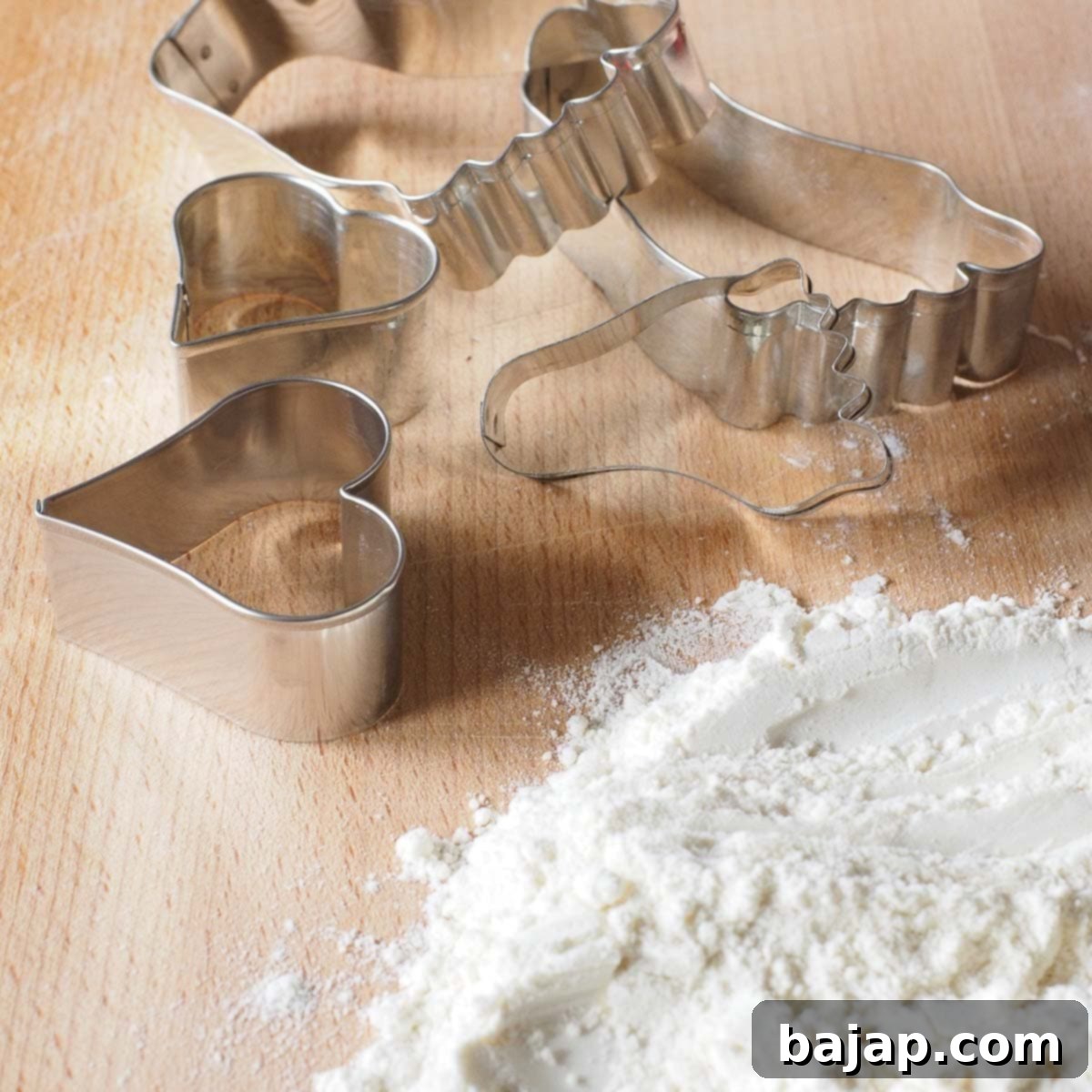The Ultimate Guide to Perfect Cookie Baking: Tips, Storage, and Essential Pantry Staples
The aroma of freshly baked cookies is truly one of life’s simple pleasures, especially as the festive season approaches and cookie baking reaches its peak. For many home bakers, this delightful time also brings a flurry of questions. Whether you’re a seasoned pro or just starting your baking journey, common queries often arise:
- Which type of dough is best suited for my desired cookies?
- What are the most effective ways to store different kinds of cookies to keep them fresh?
- What crucial details should I pay attention to while baking to ensure perfect results?
- How long can I expect my homemade cookies to last?
- And many more baking dilemmas that come with creating delicious treats.
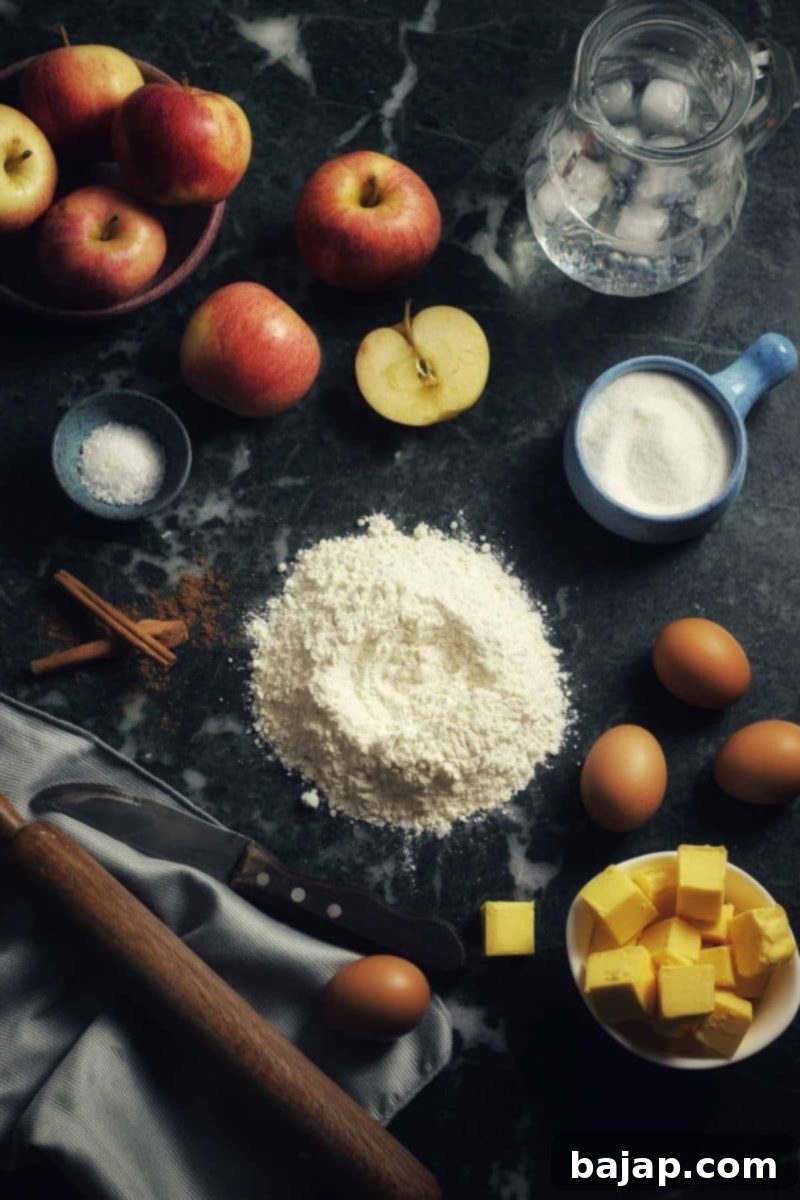
Today’s comprehensive guide is designed to address these fundamental questions and equip you with the essential knowledge for successful cookie baking, with a special focus on Christmas cookies. We’ll delve into a range of topics including:
- Understanding the nuances between various types of cookie dough.
- Exploring different kinds of sugar and their optimal uses in baking.
- Effective methods and timelines for storing diverse cookie varieties.
- Creative and delicious recipe ideas for utilizing leftover egg whites and yolks, minimizing waste and maximizing flavor.
Strategic Planning for Your Cookie Baking Marathon
Successful cookie baking, especially for a large batch or diverse assortment, begins with careful planning. Creating a timetable based on the specific dough type is a smart approach to ensure timely production and optimal flavor development for each treat.
- Honey pastry, such as gingerbread, benefits immensely from a lengthy ripening period. It should ideally be prepared about four weeks in advance, allowing it to soften and its complex flavors to fully develop over time. This waiting period is crucial for achieving that signature tender texture and rich taste.
- The same principle applies to certain egg pastries, which are often quite firm when freshly baked. These cookies, too, require time for their texture to mellow and their flavors to deepen, becoming wonderfully soft and aromatic after a few weeks of storage.
- In contrast, pastries made from shortbread, baking powder, and egg white doughs are best enjoyed fresh. Their delicate textures and vibrant flavors are at their peak shortly after baking. For these varieties, plan to bake them closer to your desired serving date or just before the holidays.
- Traditional Christmas Stollen also needs a cooling and resting period of several days after baking to allow its flavors to meld and its texture to mature.
Beyond timing, consider these practical preparation steps:
- Always gather all your ingredients and necessary equipment before you begin. This ‘mise en place’ approach streamlines the baking process, preventing last-minute rushes and potential mistakes.
- Embrace the use of baking paper or silicone baking mats. Baking paper eliminates the need to grease trays, making cleanup easier. It also allows you to prepare subsequent trays while the first batch is baking, significantly speeding up the process. High-quality baking paper can often be reused multiple times. Even more eco-friendly and practical are durable silicone baking mats, which can be used thousands of times, offering excellent non-stick properties.
- Always bake a small batch as a test. This is a crucial step that can save your entire batch. If your test cookies spread too much or lose their shape, you can easily adjust the dough by adding a little more flour, grated nuts, or ground almonds. This ensures your final cookies have the perfect texture and appearance.
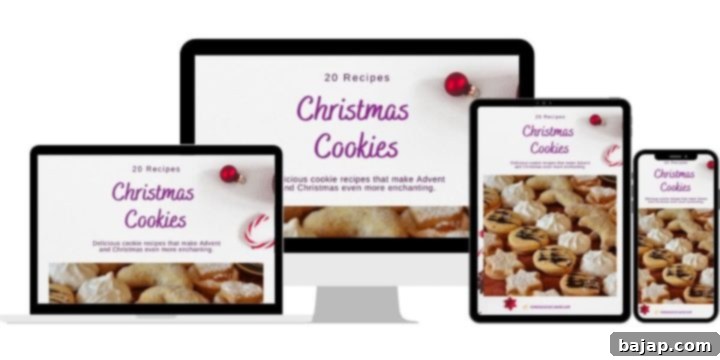
Christmas CookieBook!
Snag that Recipe eBook!
Discover 20 delicious Christmas Cookie recipes in our exclusive eBook!
Yes, please!
Essential Baking Tips for Perfect Cookies
Mastering the oven is key to perfect cookies. Always preheat your oven sufficiently. This is especially important for delicate Christmas cookies, as a consistent temperature from the moment they enter the oven ensures even baking and prevents spreading. Follow your recipe’s instructions carefully regarding oven temperature.
Pay close attention to whether the recipe instructs you to place cookies into a preheated or a cold oven. If the recipe doesn’t specify top or bottom heat, or if you’re using a convection setting, placing the baking tray on the middle shelf is generally the best approach. This allows the heat to circulate evenly around the tray, promoting uniform baking and golden-brown results.
Baking with the oven closed is crucial for pastries that rely on steam to rise and develop their texture. This technique is highly recommended for shortbread, yeast doughs, choux pastry, or puff pastry. The steam generated within the closed oven environment helps these cookies achieve their characteristic lift and airy structure, contributing significantly to their success.
Conversely, the term “hung” or “open” refers to leaving the oven door slightly ajar during baking. This allows steam to escape, promoting a drier, crispier texture. The easiest way to achieve this is by wedging a wooden spoon handle or a folded dish towel between the oven door and its frame. This technique is particularly useful for items like sponge cakes, casseroles, or puddings, where excessive moisture can lead to a soggy texture.
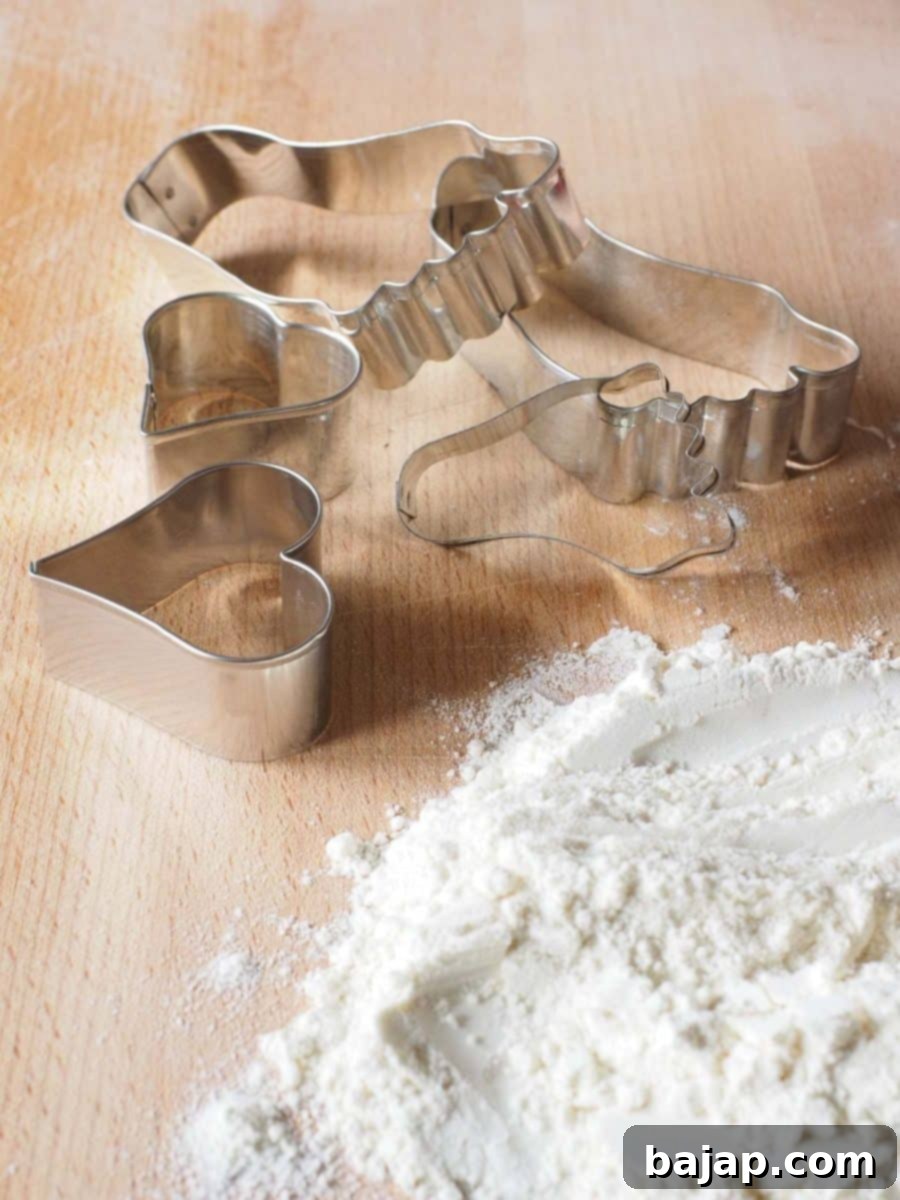
Cooling and Storing Your Delicious Cookies Properly
The post-baking process is just as important as the baking itself when it comes to preserving the quality and texture of your cookies. After baking, carefully remove the pastries from the tray. Avoid stacking them while they are still warm, as this can trap steam, making them soggy and causing them to stick together. Instead, transfer them to a wire rack to cool completely. This allows air to circulate around them, ensuring they cool evenly and maintain their crispness.
Once thoroughly cooled, stack your cookies in layers within an airtight cookie tin. To prevent flavors from mingling and to keep different varieties distinct, separate each layer with greaseproof paper or aluminum foil. For cookies that tend to dry out, a small trick is to add a slice of fresh bread, an apple wedge, or an orange peel to the tin. The moisture from these items will help keep the cookies soft and fresh, just be sure to replace them every few days to prevent mold.
Almost all cookies can be stored, and for many, a period of ripening is actually essential for their flavors to fully develop. The ideal storage container often depends on the type of cookie. However, one golden rule always applies: store each type of cookie on its own. This prevents flavors from transferring and ensures each cookie retains its unique taste and aroma.
Shortbread Cookies
Shortbread cookies, known for their buttery and crumbly texture, are best stored in a tin can. The slight air circulation in a tin is beneficial for their texture. They truly taste even better after a few days to a week of ripening, allowing their rich butter flavor to deepen. Stored correctly, shortbread can stay fresh for two to three weeks.
Confectionery and Cookies Filled with Creams
For cookies filled with creams, custards, or fresh fruit, airtight containers are essential. If your filling includes fresh whipped cream, butter, or other perishable ingredients, these treats are best kept in the refrigerator. Depending on the specific ingredients, their shelf life typically ranges from a few days to a good week.
Macaroons and Moist Pastries
Macaroons and other moist pastries need to be protected from further moisture to maintain their delicate texture. Store them as airtight as possible. Well-sealing plastic containers or tightly sealed freezer bags are ideal for this purpose. Delicate pastries made from nut dough, however, often benefit from storage in tins, similar to shortbread, to prevent them from becoming overly soft.
Gingerbread and Honey Pastry
Gingerbread and other honey-based pastries truly shine after a ripening period of at least a week in airtight tins. To prevent them from becoming too hard, include a piece of apple in the tin. Remember to change the apple slice every couple of days to avoid mold. For honey pastry, take it out of the tin about three hours before eating to allow it to soften to its perfect consistency.
Mastering Sugars: Which Type to Use for What?
Sugar is more than just a sweetener; it plays a vital role in the texture, color, and structure of your baked goods. Understanding the different types and their uses is crucial for successful cookie baking:
- Granulated Sugar (Classic White Sugar) – This all-purpose sugar is essential for dishes and drinks where sugar is dissolved or boiled with liquid. Its fine crystals are particularly effective when whipping egg yolks or butter masses for a long time, as it helps incorporate air and creates a creamy, firm consistency, especially in meringue.
- Universal Fine Crystal Sugar – With its very fine texture, this sugar dissolves easily in both cold and hot preparations. It’s excellent for sweetening beverages, dressings, and many baked goods where a smooth, uniform sweetness is desired without a gritty texture.
- Baking Sugar – Specifically designed for fine pastries, especially Austrian varieties, due to its incredibly fine granularity. It mixes exceptionally well into batters and doughs, dissolving quickly and evenly, ensuring a consistent texture and sweetness throughout.
- Brown Sugar – A blend of granulated sugar, caramel, and cane sugar syrup, brown sugar offers a distinct moistness and a rich, slightly molasses-like flavor. It’s perfect for coffee, other beverages, and any baking where a special tart-sweet or caramelized note is desired, contributing to a chewier texture in cookies.
- Confectioner’s Sugar (Powdered Sugar / Icing Sugar) – This is finely ground granulated sugar, often with a small amount of cornstarch to prevent caking. Its fine texture makes it ideal for delicate pastries, dusting baked goods, and sweetening whipped cream. Because it dissolves rapidly in liquids, it’s the go-to for smooth glazes and frostings.
- Caster Sugar – Known for being particularly free-flowing and slightly coarser than confectioner’s sugar but finer than granulated. It’s perfect for sprinkling on pastries, cakes, desserts, and fruit, adding a subtle sparkle. It holds its form well and doesn’t melt easily, even on warm treats.
- Hail Sugar (Pearl Sugar) – These large, opaque sugar crystals are primarily used for decorating. They retain their shape and don’t melt during baking, providing a lovely crunchy texture and decorative finish to brioches, chouquettes, and various cookies.
Important Considerations When Preparing Cookie Dough
The quality of your cookie dough directly impacts the final product. Paying attention to these details can make a significant difference:
- Always work with room-temperature fat, such as butter or margarine. Fat at room temperature is pliable enough to incorporate air effectively when creamed, allowing it to reach its maximum whipping volume. This aeration is critical for light and tender cookies. Remember to take your fat out of the refrigerator well in advance. If you forget, a microwave can gently soften it, but be careful not to melt it.
- Similarly, when combining yolks or whole eggs with fat, ensure the eggs are also at room temperature. Cold eggs can cause the fat to seize, resulting in a lumpy mixture. Taking them out ahead of time allows them to emulsify smoothly with the fat. It’s also important to beat them into the mixture one at a time, incorporating each fully before adding the next.
- If your recipe calls for grated nuts, they should typically be folded gently into beaten egg whites. This ensures the airy structure of the egg whites is maintained, contributing to a lighter cookie texture.
- Doughs or masses that incorporate beaten egg whites, like meringues or certain macaroons, should be transferred to the hot oven immediately after the egg whites have been folded in. Delaying this step can cause the egg whites to deflate, resulting in cookies that don’t rise properly and may become dense or greasy.
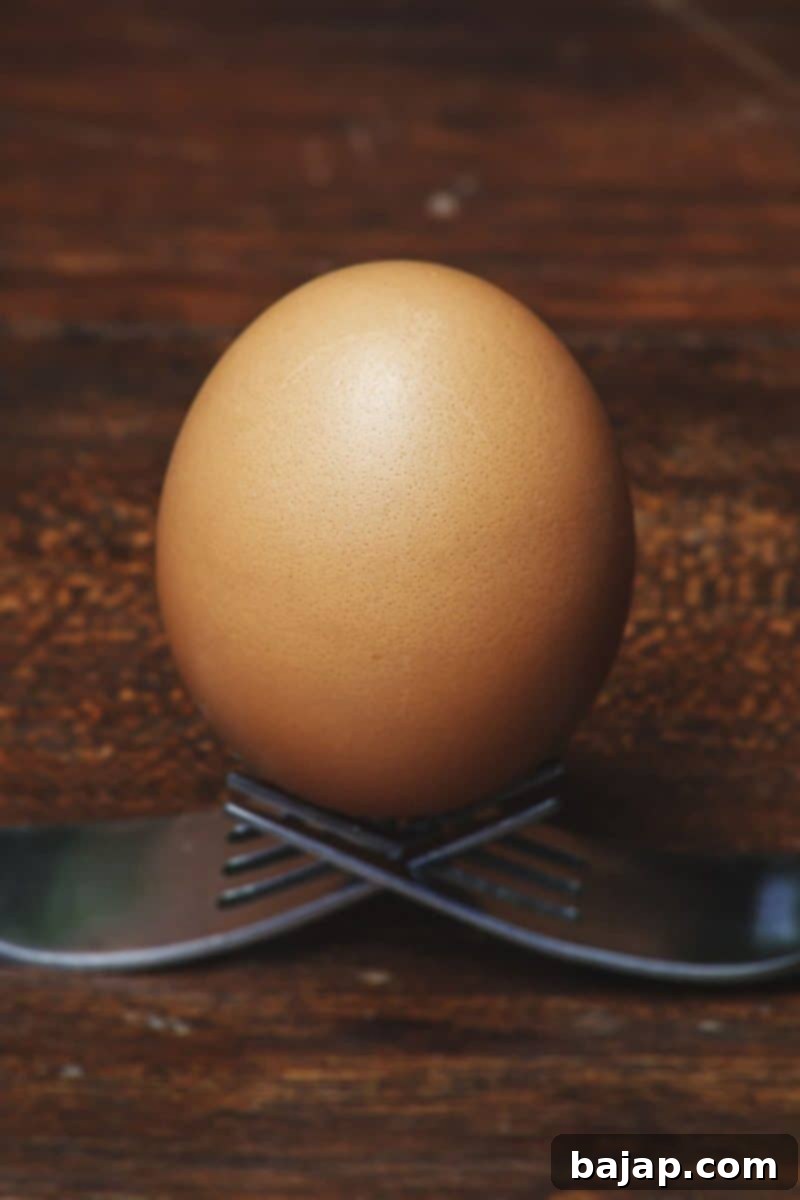
Creative Egg White Utilization: No Waste, All Taste!
Don’t let leftover egg whites go to waste! They are incredibly versatile for a variety of delicious treats. Collect any unused egg whites in a small, airtight container and make a note of the quantity. You can store them in the refrigerator for up to three days, or for longer-term storage, freeze them.
Frozen egg whites can last for approximately 8 months. When you’re ready to use them, simply thaw them in the refrigerator overnight. Once thawed, they can be easily processed as usual in your favorite recipes. Here are some fantastic ideas for transforming those leftover egg whites into delightful creations:
- Delicate Coconut “Busserl” Cookies
- Crunchy Walnut Meringue Cookies
- Elegant Pavlova
- Fragrant Zimtsterne (Cinnamon Stars)
- Rich Chocolate Egg White Cake
- Fluffy Angel Food Cake
- A light and airy soufflé
Savvy Yolk Utilization: Enhancing Flavor and Texture
Just like egg whites, leftover yolks are too valuable to discard. To store them, place the yolks in a small cup and cover them completely with cold water; this prevents them from drying out or forming a skin. They will keep in the refrigerator for a few days. For longer storage, yolks can also be frozen for about 8 months. Be sure to note the number of yolks on the container for easy reference later.
A simple way to use leftover yolks is to add one to almost any baking recipe that calls for eggs; they act as a natural quality enhancer, adding richness, moisture, and a lovely golden color to cookie batters and other baked goods. Beyond that, here are some delicious recipes specifically designed to make the most of your remaining yolks:
- Decadent Linzer Cookies with Egg Liqueur
- Creamy Homemade Egg Liqueur (Advocaat)
- Rich Walnut Cookies
- Soft Egg Yolk Cookies
- Velvety Homemade Vanilla Ice Cream
- Classic Custard or Vanilla Sauce
- Fluffy Buchteln (Filled Sweet Rolls)
- Tender Sour Cream Cookies
- Elegant Duchess Potatoes
- A rich hollandaise or béarnaise sauce
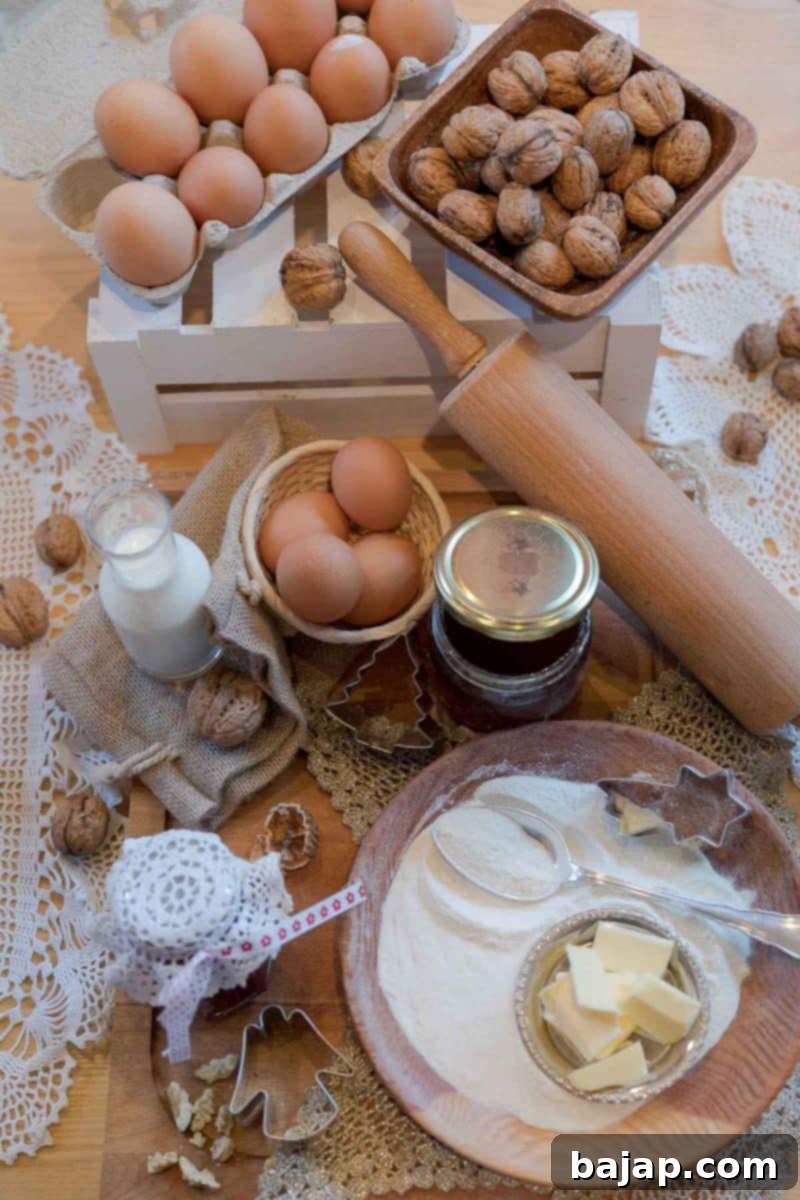
Essential Basic Baking Tools for Every Cookie Enthusiast
Having the right tools can transform your baking experience, making it more efficient and enjoyable. Here’s a list of essential equipment for successful cookie baking:
- Oven – Undoubtedly, the absolute foundation for any baking endeavor. Ensure it’s calibrated and preheats reliably.
- Kitchen Scale – For accurate weighing of ingredients, which is paramount in baking to ensure consistent and perfect results. Precision is key!
- Stand Mixer // Kitchen Machine with a dough hook, flat beater, and whisk attachment – an invaluable investment for effortlessly creaming butter and sugar, developing gluten in doughs, and whipping egg whites to perfection, saving considerable time and effort.
- Rolling Pin – Essential for evenly rolling out various types of dough to the desired thickness, ensuring consistent cookie size and bake.
- Plastic Wrap – Crucial for covering bowls of dough that need to rest or chilling dough to prevent it from drying out and absorbing fridge odors.
- Measuring Cups – For accurately measuring liquid ingredients, an absolute necessity for following recipes precisely.
- Measuring Spoons – Indispensable for small quantities of ingredients like baking powder, extracts, and spices, ensuring flavor balance.
- Mixing Bowls – A variety of sizes is useful for combining ingredients, preparing separate components, and preventing spills.
- Close-Meshed Sieve – To sift flour and confectioner’s sugar, preventing lumps and aerating ingredients for lighter baked goods. Also useful for dusting finished cookies.
- Dough Spatula / Scraper – Ideal for scraping down bowls, dividing dough, and transferring delicate cookies.
- Sealable Containers – Essential for storing prepped ingredients like egg yolks or whites, creams, or liquids, and for keeping odors contained in the refrigerator.
- Cookie Cutters – Always good to have a varied collection at home for different shapes and sizes, adding fun and visual appeal to your cookies.
- Water Bath (Bain-Marie) or Tempering Device – Indispensable for gently melting chocolate without scorching it, achieving a smooth, glossy finish for glazes and decorations.
- Thermometer – Especially for working with chocolates, custards, or specific doughs, a thermometer is an indispensable utensil for achieving precise temperatures and perfect consistency.
- Pastry Bags with Different Tips – For precise application of creams, whipped cream, glazes, and intricate decorations, adding a professional touch to your cookies.
- Baking Trays/Sheets – Multiple trays allow for continuous baking, essential for large batches.
- Whisk – For hand-mixing dry ingredients, incorporating air into eggs, or emulsifying liquids.
- Baking Mats or Parchment Paper – Provides a non-stick surface, ensuring easy removal of cookies and consistent baking.
- Pastry Brush – For brushing egg washes, glazes, or melted butter onto cookies and other baked goods before or after baking.
Stocking Your Pantry: The Foundation of Great Baking
A well-stocked pantry is a baker’s best friend. Before embarking on your Christmas baking adventures, ensure your pantry is brimming with these essential ingredients, so you’re always prepared for any recipe inspiration that strikes:
- Flour – A diverse selection is key. Keep a good supply of all-purpose flour for general baking, pastry flour for lighter, more tender results, and whole wheat flour for added fiber and a nuttier flavor. Consider expanding your repertoire with specialty flours; chestnut flour and potato flour add unique flavors and textures, making your baked goods stand out. You might also explore glutinous rice flour for an interesting chewy quality.
- Confectioner’s Sugar (Powdered Sugar) – Essential for delicate glazes, dusting, and achieving smooth textures in frostings.
- Granulated Sugar – Your workhorse sugar for most cookie recipes, providing sweetness and structure.
- Cornstarch – A fantastic thickener for fillings and a secret ingredient for tender cookies; a small addition can make cookies softer and less likely to spread.
- Baking Powder, Baking Soda, or Natron – These are your leavening agents, crucial for giving cookies their lift and desired texture.
- Baking powder is a balanced mixture of sodium bicarbonate, a weak acid (like tartaric acid), and a starch to keep it dry. It’s suitable for almost all baked goods, especially those that need to be stored for a longer period. As the number one raising agent, it ensures doughs rise beautifully and become light and airy.
- Baking soda (sodium bicarbonate) works similarly but requires an acidic ingredient (like buttermilk, yogurt, or brown sugar) in the recipe to activate it.
- Vanilla Sugar – Provides a delightful vanilla aroma and flavor. You can easily make homemade vanilla sugar or opt for high-quality store-bought versions.
- Instant Yeast or Active Dry Yeast – While less common for cookies, yeast is vital for certain sweet rolls and pastries, providing both lift and a distinct aromatic flavor.
- Yeast not only ensures that a dough rises but also develops complex aroma substances and their precursors. It imparts a characteristic taste to many baked goods. The longer the fermentation process, the richer and more varied the flavor becomes. Its high content of B vitamins also makes yeast baked goods a valuable food source.
- Vanilla Beans – For the purest, most intense vanilla flavor, especially in creams or custards.
- Nuts – Keep a variety on hand, ideally in both whole and grated or ground forms (almonds, walnuts, hazelnuts). They add flavor, texture, and richness to countless cookie recipes.
- Dried Fruit – Raisins, cranberries, apricots, or candied peel add bursts of sweetness and chewiness to cookies.
- Chocolate Chips – A classic for a reason! Milk, dark, or white chocolate chips are perfect for adding melty goodness.
- Chocolate Couverture – Essential for creating professional-looking glazes and for dipping cookies, ensuring a smooth, tempered finish.
- Cocoa Powder – For all your chocolate-flavored baking. We highly recommend using Criollo cocoa powder for its superior quality and rich, nuanced chocolate flavor without bitterness.
- High-Quality Oil – Some recipes call for oil instead of butter. Having a good quality neutral-flavored oil (like canola or grapeseed) or a flavorful one (like olive oil for certain savory-sweet cookies) is beneficial.
- Kosher Salt – Enhances the flavor of all ingredients and balances sweetness. A pinch of salt is crucial in almost every sweet recipe.
- Spices – Especially for holiday baking, ensure you have fresh ground cinnamon, vanilla extract, anise, cloves, nutmeg, and cardamom. These spices are the heart and soul of festive cookies.
For perishable items like eggs, fresh fruits (such as apples or chestnuts), and dairy products (including butter, yogurt, buttermilk, milk, heavy cream, etc.), we strongly recommend purchasing them fresh, ideally just before your planned baking session, to ensure maximum freshness and quality.
Further Reading for the Curious Baker
- Discover how to make fresh butter at home.
- Unlock the rich flavor of brown butter and how to make it.
🍪 You might also like these delightful recipes!
- No-bake Candy Cane Oreo Cake Pops
- French Press Eggnog Coffee Recipe
- How to make a Snowball Cocktail
- Ugly but Good Chocolate Chip Marshmallow Cookies
⛑️ Important Food Safety Considerations for Bakers
Ensuring food safety is paramount in any kitchen, especially when handling ingredients for baking. Follow these guidelines to keep your baking experience safe and healthy:
- Always cook ingredients, especially those involving eggs or raw flour (if not baking thoroughly), to a minimum internal temperature of 165 °F (74 °C) to eliminate harmful bacteria.
- To prevent cross-contamination, never use the same utensils or cutting boards on cooked food that have previously touched raw meat or unbaked dough containing raw eggs.
- Thoroughly wash your hands with soap and warm water for at least 20 seconds after handling raw meat, eggs, or unbaked dough.
- Avoid leaving perishable food items, especially those containing dairy or eggs, sitting out at room temperature for extended periods. Promptly refrigerate or freeze as needed.
- Never leave cooking food unattended, particularly when using high heat or frying, to prevent burning or fire hazards.
- When frying or baking at high temperatures, use oils with a high smoke point (e.g., canola, grapeseed, or refined avocado oil) to avoid the production of harmful compounds.
- Always ensure good ventilation in your kitchen when using a gas stove, oven, or any cooking appliances, especially to dissipate fumes and prevent carbon monoxide buildup.
For more detailed information and comprehensive guidelines on safe food handling practices, please refer to the official resources provided by the U.S. Food and Drug Administration (FDA).
